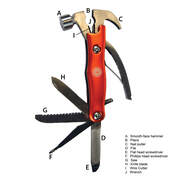Tools
Having the right tool for the job is critical. Not having the right tool can make the task nearly impossible. But you don’t always need to take all your tools with you. Plan for the specific terrain, weather and situation.
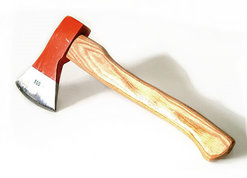
Here's the type of tools that we like for camping and why we like them:
- Pocket Knife
- Automatic Locking Blade Knife
- Survival Knife with Sharpening Stone
- Fingerless Work Gloves
- Waterproof Cold Weather Gloves
- Machete with Case
- Small Sharpening Stone for Machete Case
- Hatchet with Case
- Pack Axe with Blade Mask
- Rough/Coarse Sharpening File for Machete, Hatchet and Axe
- Coarse/Medium Sharpening Stone for Knives, Machete, Hatchet and Axe
- Fine Whetstones for Sharpening Knives, Machete, Hatchet and Axe
- Small Knife Sharpener
- Multi-tool (Pliers-based)
- Multi-tool (Hammer-based)
- Folding Saw
- Chain/Wire Saw
- Small Plastic Trowel
- Folding Shovel with Case
- 550 Paracord
- Nylon Rope
- Survival Fishing Kit
- Fishing Line
- Survival Fishing Net
- Small Animal Snare Kit
- Braided Steel Wire
- Camping Shower/Water Pump
- Flexible Plastic Tubing
- Tubing Clamps
- Hockey Stick Tape for Wrapping Tool Handles
- Large Binoculars
- Note: click on any photo to enlarge it
- Note: click on any photo to enlarge it
Pocket Knife
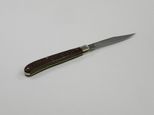
Case Cutlery 135 Case Slimline Trapper Pocket Knife
Given all the little things that come up that need to be cut, shaved or whittled having a pocket knife is a must in the backcountry. These days many people opt for what I consider overly complicated multi-bladed knives. I prefer a single-bladed knife. The criteria that we use to evaluate pocket knives are: 1) length of blade, 2) strength of blade, 3) feel in your hand, 4) reputation of manufacturer and 5) price. I’ve carried a Case Slimline Trapper pocket knife for years. I actually like them so much that I always keep a spare at the house in case I misplace the one that I am carrying. The Case Slimline Trapper has a synthetic handle and a surgical steel clip blade. The knife has a blade that is 3 1/4" long, measures 4 1/8" closed and weighs 2.3 oz. Due to its slim size the knife fits comfortably in a my front pocket. You can buy this pocket knife at Amazon.
Given all the little things that come up that need to be cut, shaved or whittled having a pocket knife is a must in the backcountry. These days many people opt for what I consider overly complicated multi-bladed knives. I prefer a single-bladed knife. The criteria that we use to evaluate pocket knives are: 1) length of blade, 2) strength of blade, 3) feel in your hand, 4) reputation of manufacturer and 5) price. I’ve carried a Case Slimline Trapper pocket knife for years. I actually like them so much that I always keep a spare at the house in case I misplace the one that I am carrying. The Case Slimline Trapper has a synthetic handle and a surgical steel clip blade. The knife has a blade that is 3 1/4" long, measures 4 1/8" closed and weighs 2.3 oz. Due to its slim size the knife fits comfortably in a my front pocket. You can buy this pocket knife at Amazon.
Automatic Locking Blade Knife
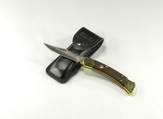
Buck 110 Auto Knife
Many times in the outback we find that we need to cut something - but have our hands full because they are holding other items – normally the items that we are trying to cut. Like most Hiking and Camping enthusiasts we take different knives with us when camping - since many times “Two is one and One is none” - and in this situation you need a knife that has three features: 1) sharpness, 2) a sturdy locking blade and 3) the ability to flip open or open automatically. The criteria that we use to evaluate automatic locking knifes are: 1) size of blade, 2) strength of blade, 3) ability of blade to retain an edge, 4) feel in your hand, 5) ease of opening, 6) reliability of opening and 7) price. To fill this need we have a Buck 110 Auto that opens with a push of a button on the handle. The knife is identical in size and shape to the classic Buck Folding Hunter knife that has been available since 1963 when Buck started making a lock blade knife for outdoorsmen who wanted a sturdy knife - but did not want to carry a long fixed-blade knife. The 110 Auto has a 3 ¾” 420HC steel blade with a crescent clip tip that makes the blade thinner and gives it a sharper point, Macassar Ebony Dymondwood handles and brass bolsters. The knife is 8 ¾” in total length, weighs 7.1 oz, and comes with a friction fit leather sheath. You can purchase either the factory Buck 110 Auto or a standard Buck 110 that has been converted to the Automatic configuration. If you are looking online you can most easily see the difference between the two variants by looking at the activation button. I’ve handled both and ended up purchasing a conversion since the activation button was larger and was flush with the knife handle. The conversion that I purchased also seems to open and lock up faster than the factory made autos that I looked at, but since it is an after-market modification it does not have The Buck “Forever” Warranty. That being said, you probably can’t go wrong with either variant, as long as you purchase a conversion from a credible source. You should be able to buy this Buck knife at your local knife dealer or you can look on gunbroker.com.
Note: The sale of the Buck 110 Auto is subject to restriction by the laws of many states and territories in the United States and by Federal law. This knife is prohibited under the Criminal Code of Canada, Part 3 Firearms and other Weapons, Section 84. Here’s a website with a good overview of knife laws by State: https://survivallife.com/knife-laws-state/
If you need more information on local knife laws, check out the American Knife & Tool Institute's (AKTI's) guide at:
https://www.akti.org/state-knife-laws/
Many times in the outback we find that we need to cut something - but have our hands full because they are holding other items – normally the items that we are trying to cut. Like most Hiking and Camping enthusiasts we take different knives with us when camping - since many times “Two is one and One is none” - and in this situation you need a knife that has three features: 1) sharpness, 2) a sturdy locking blade and 3) the ability to flip open or open automatically. The criteria that we use to evaluate automatic locking knifes are: 1) size of blade, 2) strength of blade, 3) ability of blade to retain an edge, 4) feel in your hand, 5) ease of opening, 6) reliability of opening and 7) price. To fill this need we have a Buck 110 Auto that opens with a push of a button on the handle. The knife is identical in size and shape to the classic Buck Folding Hunter knife that has been available since 1963 when Buck started making a lock blade knife for outdoorsmen who wanted a sturdy knife - but did not want to carry a long fixed-blade knife. The 110 Auto has a 3 ¾” 420HC steel blade with a crescent clip tip that makes the blade thinner and gives it a sharper point, Macassar Ebony Dymondwood handles and brass bolsters. The knife is 8 ¾” in total length, weighs 7.1 oz, and comes with a friction fit leather sheath. You can purchase either the factory Buck 110 Auto or a standard Buck 110 that has been converted to the Automatic configuration. If you are looking online you can most easily see the difference between the two variants by looking at the activation button. I’ve handled both and ended up purchasing a conversion since the activation button was larger and was flush with the knife handle. The conversion that I purchased also seems to open and lock up faster than the factory made autos that I looked at, but since it is an after-market modification it does not have The Buck “Forever” Warranty. That being said, you probably can’t go wrong with either variant, as long as you purchase a conversion from a credible source. You should be able to buy this Buck knife at your local knife dealer or you can look on gunbroker.com.
Note: The sale of the Buck 110 Auto is subject to restriction by the laws of many states and territories in the United States and by Federal law. This knife is prohibited under the Criminal Code of Canada, Part 3 Firearms and other Weapons, Section 84. Here’s a website with a good overview of knife laws by State: https://survivallife.com/knife-laws-state/
If you need more information on local knife laws, check out the American Knife & Tool Institute's (AKTI's) guide at:
https://www.akti.org/state-knife-laws/
Survival Knife with Sharpening Stone
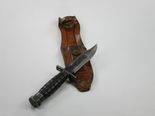
Army Survival Knife
Although I carry a pocket knife I also find the need for a heavier and stronger knife when camping. The criteria that we use to evaluate survival knives are: 1) size of blade, 2) quality of blade, 3) heft of blade, 4) sheath, 5) sharpening stone and 6) price. For that I use an Army Survival Knife that my father, who was a Huey pilot, gave to me years ago. I really like the fact that the knife is built like a tank and can be used for all sorts of tasks. The overall length of the knife is 9.5”. The blade is 5” long and is made of 1095 carbon steel that is - 0.1875 thick with a Zinc phosphate finish that inhibits rust. The knife also has saw teeth on the spine, a steel butt cap that comes in handy for lots of things, a sharpening stone and a natural leather handle. You can buy survival knives at Amazon. Just make sure that you don’t but one of the cheap knockoff knives.
Although I carry a pocket knife I also find the need for a heavier and stronger knife when camping. The criteria that we use to evaluate survival knives are: 1) size of blade, 2) quality of blade, 3) heft of blade, 4) sheath, 5) sharpening stone and 6) price. For that I use an Army Survival Knife that my father, who was a Huey pilot, gave to me years ago. I really like the fact that the knife is built like a tank and can be used for all sorts of tasks. The overall length of the knife is 9.5”. The blade is 5” long and is made of 1095 carbon steel that is - 0.1875 thick with a Zinc phosphate finish that inhibits rust. The knife also has saw teeth on the spine, a steel butt cap that comes in handy for lots of things, a sharpening stone and a natural leather handle. You can buy survival knives at Amazon. Just make sure that you don’t but one of the cheap knockoff knives.
Fingerless Work Gloves
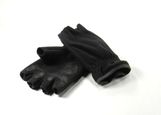
Glacier Glove Cold River Windproof Fleece Fingerless Gloves
When walking and working in the backcountry, and especially in the mountains, we find that we often need gloves to protect our hands from the cold and the rocks. But we also need dexterity to hold onto items and to perform work tasks. The solution that works for us is a good quality pair of fingerless gloves. The criteria that we use to evaluate fingerless gloves are: 1) fit, 2) durability, 3) warmth and 4) price. We like the Glacier Glove Cold River Windproof Fleece fingerless gloves because they are warm enough while simultaneously allowing your fingers to be free for working. Since they are made of windproof fleece with polyurethane patches for better gripping they do the trick for us. Some of the reviews that we read prior to purchasing these gloves talked about their bulkiness and usefulness, but the review were written by people looking for gloves to keep their hands warm while they were typing; so I’m not sure that they bought the right gloves in the first place. We like them – but then maybe that’s our personal preference. You can buy these gloves at Amazon.
When walking and working in the backcountry, and especially in the mountains, we find that we often need gloves to protect our hands from the cold and the rocks. But we also need dexterity to hold onto items and to perform work tasks. The solution that works for us is a good quality pair of fingerless gloves. The criteria that we use to evaluate fingerless gloves are: 1) fit, 2) durability, 3) warmth and 4) price. We like the Glacier Glove Cold River Windproof Fleece fingerless gloves because they are warm enough while simultaneously allowing your fingers to be free for working. Since they are made of windproof fleece with polyurethane patches for better gripping they do the trick for us. Some of the reviews that we read prior to purchasing these gloves talked about their bulkiness and usefulness, but the review were written by people looking for gloves to keep their hands warm while they were typing; so I’m not sure that they bought the right gloves in the first place. We like them – but then maybe that’s our personal preference. You can buy these gloves at Amazon.
Waterproof Cold Weather Gloves
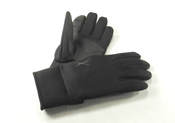
Seirus Innovation 1171 Mens Xtreme Waterproof All Weather Form Fit Glove with Soundtouch Touch Screen Technology
If you’re outdoors, and the weather is both cold and wet, one invaluable piece of gear that you need is a good pair of waterproof gloves. The only problem is that many waterproof gloves don’t breathe, don’t allow you to have good dexterity and aren’t sturdy enough for actually doing real work - like chopping wood. The criteria that we use to evaluate waterproof gloves are: 1) fit, 2) durability, 3) warmth 4) dexterity, 5) comfort and 6) price. Recently we’ve spent a fair amount of time looking for a good pair of waterproof gloves that fits these criteria and finally found a pair that we liked; Seirus Innovation 1171 Mens Xtreme Waterproof gloves. Made from a combination of fleece, Lycra, neoprene, nylon and spandex these gloves are 100% waterproof, but are also flexible and breathe. The gloves are constructed with three layers: a stretchable outer shell, a windproof/waterproof middle membrane, and a fleece inner lining for warmth and to wick away moisture. We like the fact that they provide a tight fit and have a tall wrist cuff that keeps out the cold air and snow – while allowing us the dexterity to use tools in the cold. As an added bonus these gloves also have “Soundtouch Touch Screen Technology” that allows you to use your smartphone without taking off your gloves. All that being said – these gloves are great for working in the cold and support that by providing good warmth with minimal bulk. If you are looking for just warmth, and don’t care about bulk or dexterity, then you should probably consider purchasing heavier winter/snow gloves. Note that the sizing of these gloves seem to run small because of their cut and fit; so if you buy them you might want to purchase the next size up from what you usually wear. You can buy these gloves at Amazon.
If you’re outdoors, and the weather is both cold and wet, one invaluable piece of gear that you need is a good pair of waterproof gloves. The only problem is that many waterproof gloves don’t breathe, don’t allow you to have good dexterity and aren’t sturdy enough for actually doing real work - like chopping wood. The criteria that we use to evaluate waterproof gloves are: 1) fit, 2) durability, 3) warmth 4) dexterity, 5) comfort and 6) price. Recently we’ve spent a fair amount of time looking for a good pair of waterproof gloves that fits these criteria and finally found a pair that we liked; Seirus Innovation 1171 Mens Xtreme Waterproof gloves. Made from a combination of fleece, Lycra, neoprene, nylon and spandex these gloves are 100% waterproof, but are also flexible and breathe. The gloves are constructed with three layers: a stretchable outer shell, a windproof/waterproof middle membrane, and a fleece inner lining for warmth and to wick away moisture. We like the fact that they provide a tight fit and have a tall wrist cuff that keeps out the cold air and snow – while allowing us the dexterity to use tools in the cold. As an added bonus these gloves also have “Soundtouch Touch Screen Technology” that allows you to use your smartphone without taking off your gloves. All that being said – these gloves are great for working in the cold and support that by providing good warmth with minimal bulk. If you are looking for just warmth, and don’t care about bulk or dexterity, then you should probably consider purchasing heavier winter/snow gloves. Note that the sizing of these gloves seem to run small because of their cut and fit; so if you buy them you might want to purchase the next size up from what you usually wear. You can buy these gloves at Amazon.
Machete with Case
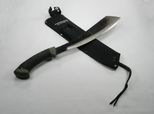
Condor Bushcraft Parang 13" Machete with Ballistic Nylon Sheath
We don’t always need a machete when we go camping, but when you do there is no other tool that can replace it. The criteria that we use to evaluate machetes are: 1) length of blade, 2) strength of blade, 3) sharpness of blade, 4) rigidity of blade, 5) ability of blade to retain an edge, 6) fit/finish of sheath and 7) price. Having used lots of machete’s over the years the shape that we prefer is the curve of the Parang so we use a 13" Condor Bushcraft parang machete. This is not a fancy “show” machete, this is a work machete. The blade is made from 4.5mm thick 1075 high carbon steel so it is plenty strong. Strong enough to chop wood. We also like the fact that the ballistic nylon sheath has a small pouch to hold a sharpening stone. Since the handle is made of polypropylene we wrapped it with hockey tape so that we could get a better grip. You can buy this machete at Amazon.
We don’t always need a machete when we go camping, but when you do there is no other tool that can replace it. The criteria that we use to evaluate machetes are: 1) length of blade, 2) strength of blade, 3) sharpness of blade, 4) rigidity of blade, 5) ability of blade to retain an edge, 6) fit/finish of sheath and 7) price. Having used lots of machete’s over the years the shape that we prefer is the curve of the Parang so we use a 13" Condor Bushcraft parang machete. This is not a fancy “show” machete, this is a work machete. The blade is made from 4.5mm thick 1075 high carbon steel so it is plenty strong. Strong enough to chop wood. We also like the fact that the ballistic nylon sheath has a small pouch to hold a sharpening stone. Since the handle is made of polypropylene we wrapped it with hockey tape so that we could get a better grip. You can buy this machete at Amazon.
Small Sharpening Stone for Machete Case
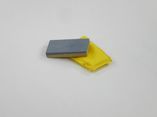
Coghlan's Sharpening Stone
Keeping your tools sharp in the backcountry is a constant struggle without the right tools, so we make sure that we have multiple ways to sharpen our knives, hatchets, machetes and other blades. Keeping your blades sharp reduces your work and reduces the risk of nasty cuts. Since the Condor parang machete sheath has a small pouch for a sharpening stone we added one there too. The criteria that we use to evaluate sharpening stones are: 1) size, 2) can it sharpen both course and fine, 3) durability, and 4) is oil required. We bought the Coghlan's Sharpening Stone because, at 3" x 1-1/2" x 1/2", it was small enough to fit into the sheath pouch but big enough to be useful. In addition, since it’s made of electric furnace abrasive grain, and has both coarse (120) and fine (400) grit sides, it’s capable of working on all our blades as needed while in the field. We also like the fact that the stone has a small vinyl carrying case that keeps it a little more protected when it is in the sheath pouch. You can buy this sharpening stone at Amazon.
Keeping your tools sharp in the backcountry is a constant struggle without the right tools, so we make sure that we have multiple ways to sharpen our knives, hatchets, machetes and other blades. Keeping your blades sharp reduces your work and reduces the risk of nasty cuts. Since the Condor parang machete sheath has a small pouch for a sharpening stone we added one there too. The criteria that we use to evaluate sharpening stones are: 1) size, 2) can it sharpen both course and fine, 3) durability, and 4) is oil required. We bought the Coghlan's Sharpening Stone because, at 3" x 1-1/2" x 1/2", it was small enough to fit into the sheath pouch but big enough to be useful. In addition, since it’s made of electric furnace abrasive grain, and has both coarse (120) and fine (400) grit sides, it’s capable of working on all our blades as needed while in the field. We also like the fact that the stone has a small vinyl carrying case that keeps it a little more protected when it is in the sheath pouch. You can buy this sharpening stone at Amazon.
Hatchet with Case
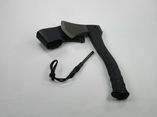
Schrade Axe with Fire Starter and Rubber Handle, Small
Like our machete, we don’t always need a hatchet – but having one is a must for many camping trips. The criteria that we use to evaluate hatchets and hand axes are: 1) size, 2) sharpness of blade, 3) heft, 4) strength and 5) price. We like the small Schrade Axe with Fire Starter and Rubber Handle since it really does what a hatchets/hand axe is supposed to do – chop stuff. The hatchet is 11.8" long, and has a 5.2" handle and a 3.8" blade. The hammer head on the backside is 1.5" by .6 in. It weighs approximately 2 lbs and has a titanium nitride coating for durability. The rubber handle’s shape and construction give the hatchet a great grip and feel in your hand. To get an even better grip we wrapped the handle with hockey tape. The hatchet also has a fire rod integrated into the handle – a thoughtful addition. The fire rod is approximately 5” in length and fits tightly into the handle with four ringed gaskets. The plastic sheath is probably the only weak point of the entire setup – but it has gotten the job done so far – so we have no real complaints. You can buy this hatchet at Amazon.
Like our machete, we don’t always need a hatchet – but having one is a must for many camping trips. The criteria that we use to evaluate hatchets and hand axes are: 1) size, 2) sharpness of blade, 3) heft, 4) strength and 5) price. We like the small Schrade Axe with Fire Starter and Rubber Handle since it really does what a hatchets/hand axe is supposed to do – chop stuff. The hatchet is 11.8" long, and has a 5.2" handle and a 3.8" blade. The hammer head on the backside is 1.5" by .6 in. It weighs approximately 2 lbs and has a titanium nitride coating for durability. The rubber handle’s shape and construction give the hatchet a great grip and feel in your hand. To get an even better grip we wrapped the handle with hockey tape. The hatchet also has a fire rod integrated into the handle – a thoughtful addition. The fire rod is approximately 5” in length and fits tightly into the handle with four ringed gaskets. The plastic sheath is probably the only weak point of the entire setup – but it has gotten the job done so far – so we have no real complaints. You can buy this hatchet at Amazon.
Pack Axe with Blade Mask
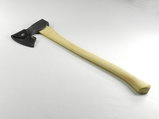
Council Tool Woodcraft Pack Axe w/24" Handle and Blade Mask (WC20PA24C)
Although we normally carry our hatchet (a small Schrade Axe) when we camp, sometimes you need more power than a hatchet can deliver. You need an axe. However, since a standard axe can be 36” long and weigh 6 lbs., there can be challenges with taking an axe camping. But there is a compromise – the “Pack Axe” – which is normally ~24” in length and weighs ~2.5 lbs. The criteria that we use to evaluate pack axes are: 1) length, 2) weight, 3) sharpness of blade, 4) ability to use the poll for hammering, 5) strength and 6) price. After looking at the many types and styles of axes on the market we purchased the Council Tool Wood-Craft Pack Axe with 24″ curved handle. The axe weighs 2.75 lbs., has a head made of 5160 steel (heat treated on both ends for strength), has a 24” curved hickory handle and includes a welted leather mask to protect you from the blade and the blade from the elements. One of the things that we really like about the Council Tool Pack Axe is that since they partnered with wood-craft and bush craft experts the axe is specifically designed to cut, chop, split, carve, shave, hew, hammer, and aid in fire starting. Although you can purchase a full cover for the axe head, we prefer the blade mask that comes with the axe since it allows you to more safely use the poll as a hammer. One thing that you want to make sure you do if you purchase the Woodcraft Pack axe is to rub boiled linseed oil into the handle to help protect it from the elements. This simple process provides a layer of finish to the handle and increases its protection from the elements. Please note that you need to use "boiled" linseed oil, not "raw" linseed oil. Raw linseed oil will not dry; in fact - it will probably remain sticky. You can buy this Pack Axe at Amazon.
Although we normally carry our hatchet (a small Schrade Axe) when we camp, sometimes you need more power than a hatchet can deliver. You need an axe. However, since a standard axe can be 36” long and weigh 6 lbs., there can be challenges with taking an axe camping. But there is a compromise – the “Pack Axe” – which is normally ~24” in length and weighs ~2.5 lbs. The criteria that we use to evaluate pack axes are: 1) length, 2) weight, 3) sharpness of blade, 4) ability to use the poll for hammering, 5) strength and 6) price. After looking at the many types and styles of axes on the market we purchased the Council Tool Wood-Craft Pack Axe with 24″ curved handle. The axe weighs 2.75 lbs., has a head made of 5160 steel (heat treated on both ends for strength), has a 24” curved hickory handle and includes a welted leather mask to protect you from the blade and the blade from the elements. One of the things that we really like about the Council Tool Pack Axe is that since they partnered with wood-craft and bush craft experts the axe is specifically designed to cut, chop, split, carve, shave, hew, hammer, and aid in fire starting. Although you can purchase a full cover for the axe head, we prefer the blade mask that comes with the axe since it allows you to more safely use the poll as a hammer. One thing that you want to make sure you do if you purchase the Woodcraft Pack axe is to rub boiled linseed oil into the handle to help protect it from the elements. This simple process provides a layer of finish to the handle and increases its protection from the elements. Please note that you need to use "boiled" linseed oil, not "raw" linseed oil. Raw linseed oil will not dry; in fact - it will probably remain sticky. You can buy this Pack Axe at Amazon.
Rough/Coarse Sharpening File for Machete, Hatchet and Axe
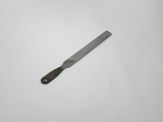
Nicholson 8" Black Diamond File
When sharpening stones can’t do the job because you have really beat up or nicked your hatchet or machete you need a file. Although we don’t usually carry a file into the backcountry, we have one to make sure that all our tools are sharpened and in top shape at home before we depart on any adventure. The criteria that we use to evaluate sharpening files are: 1) can it sharpen both course and fine, 2) strength, and 3) durability. We like the Nicholson 8" Black Diamond file because it because one side is single cut for tool sharpening and smoothing metal surfaces and the other side is double cut for general filing and rapid metal removal. But what we like the most is the file’s handle. Most files don’t have a hand grip, but this one does. You can buy this file at Amazon.
When sharpening stones can’t do the job because you have really beat up or nicked your hatchet or machete you need a file. Although we don’t usually carry a file into the backcountry, we have one to make sure that all our tools are sharpened and in top shape at home before we depart on any adventure. The criteria that we use to evaluate sharpening files are: 1) can it sharpen both course and fine, 2) strength, and 3) durability. We like the Nicholson 8" Black Diamond file because it because one side is single cut for tool sharpening and smoothing metal surfaces and the other side is double cut for general filing and rapid metal removal. But what we like the most is the file’s handle. Most files don’t have a hand grip, but this one does. You can buy this file at Amazon.
Coarse/Medium Sharpening Stone for Knives, Machete, Hatchet and Axe
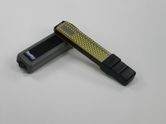
Smith's 4" Diamond Combination Sharpener
Although we have some other small sharpening stones for on the spot touchups and for backup, we find that having a dedicated larger sharpening stone for the initial sharpening efforts is the way to go. The criteria that we use to evaluate larger sharpening stones are: 1) size, 2) can it sharpen both course and fine, 3) comfort in your hand, 4) protection of the stone when not in use, 5) is oil required and 6) price. We like the fact that the Smith's 4" x 1” Diamond Combination Sharpener has a soft grip rubber handle with a thumb guard and is constructed so that the stone fits inside the handle when not in use. Since the stone has both coarse (325-grit surface) and fine diamond (750-grit surface) stones in one sharpener it allows us to do all the sharpening that we need to do without changing stones. The stone also has a microtool sharpening pad and a sharpening groove for fish hooks and small pointed tools. You can buy this knife sharpener at Amazon.
Although we have some other small sharpening stones for on the spot touchups and for backup, we find that having a dedicated larger sharpening stone for the initial sharpening efforts is the way to go. The criteria that we use to evaluate larger sharpening stones are: 1) size, 2) can it sharpen both course and fine, 3) comfort in your hand, 4) protection of the stone when not in use, 5) is oil required and 6) price. We like the fact that the Smith's 4" x 1” Diamond Combination Sharpener has a soft grip rubber handle with a thumb guard and is constructed so that the stone fits inside the handle when not in use. Since the stone has both coarse (325-grit surface) and fine diamond (750-grit surface) stones in one sharpener it allows us to do all the sharpening that we need to do without changing stones. The stone also has a microtool sharpening pad and a sharpening groove for fish hooks and small pointed tools. You can buy this knife sharpener at Amazon.
Fine Whetstones for Sharpening Knives, Machete, Hatchet and Axe
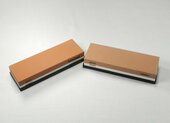
Unimi Professional Sharpening Water Stones (600/1,000 Grit and 2,000/6,000 Grit)
Keeping your knives and other blades sharp is critical since a sharp blade really reduces the effort you need to expend to cut something. So, for our initial sharpening efforts we have a dedicated sharpening stone (325/750 grit) and for on the spot touchups, and backup in the outback, we have a small sharpening stone (120/400 grit). We even have a file for when we’ve really nicked up our machete, hatchet or axe blades. But in our experience, to really sharpen your blades correctly you need three sharpening stones - one to rough-grind, one to sharpen and one to hone. So these first two stones (both below 1,000 grit) only get you part of the way since they are really only useful for removing nicks or chips in the blade and getting the blade’s initial edge formed. To really get a sharp edge you need sharpening stones with 1,000 to 6,000 grit. Stones with 1,000 to 3,000 grit are good for sharpening dull knives and stones with 4,000 to 6,000 grit are finishing stones used to refine your knife’s edge. The criteria that we use to evaluate fine whetstones are: 1) size, 2) grit, 3) stability when in use, 4) does it contain more than one grit [e.g. each side a different grit], 5) lubrication requirements [we prefer water over oil] and 6) price. For medium to fine sharpening and honing we have two different dual-sided Unimi Professional sharpening water stones; one with 600/1,000 grit and the other with 2,000/6,000 grit – both for use before we head out on any adventure. We use the 600 side on dull knives and for final touches reshaping blades, and use the finer 1,000 grit stone for the finishing touches on our “work” knives, machete, hatchet and axe. We use the 2,000 grit side to take off the fine scratches and burrs left by coarser stones, and for even finer honing, and use the 6,000 grit side to achieve a razor-sharp finish on our more delicate knives. Each of the Unimi stones measure 7.09" x 2.36" x 1.18", weighs 12 ¾ ounces and comes with a rubber base to provide support and stability for the stone when it’s in use. We find that the size of these stones is great since the bigger the stone, the faster you can work (smaller stones can work just as well - they just take a little longer to sharpen the same blade). The stones are both made out of White Corundum and each side is labeled and color coded so that you can easily tell what grit you are using. These are great stones at a great price – especially since you can spend literally hundreds of dollars purchasing some other brands of sharpening stones. You can buy both of these Unimi stones at Amazon: 600/1,000 water stone and 2,000/6,000 water stone.
Keeping your knives and other blades sharp is critical since a sharp blade really reduces the effort you need to expend to cut something. So, for our initial sharpening efforts we have a dedicated sharpening stone (325/750 grit) and for on the spot touchups, and backup in the outback, we have a small sharpening stone (120/400 grit). We even have a file for when we’ve really nicked up our machete, hatchet or axe blades. But in our experience, to really sharpen your blades correctly you need three sharpening stones - one to rough-grind, one to sharpen and one to hone. So these first two stones (both below 1,000 grit) only get you part of the way since they are really only useful for removing nicks or chips in the blade and getting the blade’s initial edge formed. To really get a sharp edge you need sharpening stones with 1,000 to 6,000 grit. Stones with 1,000 to 3,000 grit are good for sharpening dull knives and stones with 4,000 to 6,000 grit are finishing stones used to refine your knife’s edge. The criteria that we use to evaluate fine whetstones are: 1) size, 2) grit, 3) stability when in use, 4) does it contain more than one grit [e.g. each side a different grit], 5) lubrication requirements [we prefer water over oil] and 6) price. For medium to fine sharpening and honing we have two different dual-sided Unimi Professional sharpening water stones; one with 600/1,000 grit and the other with 2,000/6,000 grit – both for use before we head out on any adventure. We use the 600 side on dull knives and for final touches reshaping blades, and use the finer 1,000 grit stone for the finishing touches on our “work” knives, machete, hatchet and axe. We use the 2,000 grit side to take off the fine scratches and burrs left by coarser stones, and for even finer honing, and use the 6,000 grit side to achieve a razor-sharp finish on our more delicate knives. Each of the Unimi stones measure 7.09" x 2.36" x 1.18", weighs 12 ¾ ounces and comes with a rubber base to provide support and stability for the stone when it’s in use. We find that the size of these stones is great since the bigger the stone, the faster you can work (smaller stones can work just as well - they just take a little longer to sharpen the same blade). The stones are both made out of White Corundum and each side is labeled and color coded so that you can easily tell what grit you are using. These are great stones at a great price – especially since you can spend literally hundreds of dollars purchasing some other brands of sharpening stones. You can buy both of these Unimi stones at Amazon: 600/1,000 water stone and 2,000/6,000 water stone.
Small Knife Sharpener
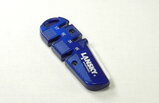
Lansky QuadSharp Knife Sharpener
Since a sharp knife is critical to so many outdoor activities, we have lots of tools to try to keep our cutting edges as honed as possible. That leads to us having several ways to sharpen our blades – from files and 6,000 grit whetstones to use at home - to small sharpening stones to use in the field. One of the smaller tools in our kit is the “Lansky QuadSharp Knife Sharpener”; a compact tool specifically made to maintain your knives at the exact angle you need their edges to be while you’re in the field. The QuadSharp has preset carbide “V” grooves for four sharpening angles to help you sharpen your blade in 3 or 4 strokes:
17º - For filet knives, scalpels, and other similar blades that require an extremely sharp but delicate edge.
20º - For high quality slicing, skinning and kitchen knives that need to be sharp and sturdy.
25º - For hunting and outdoor knives that need a sharp but durable edge.
30º - The most durable edge for knives that see heavy use such as cutting rope, or cardboard or are used for chopping.
The QuadSharp also has a sturdy metal body, an 800 grit ceramic benchstone for fine polishing, and can be used on regular, serrated (by sharpening one serration at a time by pulling the ceramic element against the grooved side of the serration) and filet knives. Measuring 4 ½” x 1 ½” x 3/8”, and weighing ~3 ounces, the QuadSharp is a small tool that’s easy to add to your gear and easy to use in the field when you can’t get to a larger sharpening stone. You can buy the “Lansky QuadSharp Knife Sharpener” at Amazon.
Since a sharp knife is critical to so many outdoor activities, we have lots of tools to try to keep our cutting edges as honed as possible. That leads to us having several ways to sharpen our blades – from files and 6,000 grit whetstones to use at home - to small sharpening stones to use in the field. One of the smaller tools in our kit is the “Lansky QuadSharp Knife Sharpener”; a compact tool specifically made to maintain your knives at the exact angle you need their edges to be while you’re in the field. The QuadSharp has preset carbide “V” grooves for four sharpening angles to help you sharpen your blade in 3 or 4 strokes:
17º - For filet knives, scalpels, and other similar blades that require an extremely sharp but delicate edge.
20º - For high quality slicing, skinning and kitchen knives that need to be sharp and sturdy.
25º - For hunting and outdoor knives that need a sharp but durable edge.
30º - The most durable edge for knives that see heavy use such as cutting rope, or cardboard or are used for chopping.
The QuadSharp also has a sturdy metal body, an 800 grit ceramic benchstone for fine polishing, and can be used on regular, serrated (by sharpening one serration at a time by pulling the ceramic element against the grooved side of the serration) and filet knives. Measuring 4 ½” x 1 ½” x 3/8”, and weighing ~3 ounces, the QuadSharp is a small tool that’s easy to add to your gear and easy to use in the field when you can’t get to a larger sharpening stone. You can buy the “Lansky QuadSharp Knife Sharpener” at Amazon.
Multi-Tool (Pliers-based)
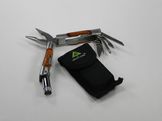
Greatland Multi-tool
As most of us have realized over the years one tool that comes in handy all the time is a multi-tool since it was specifically designed and made to be a jack-of-all-trades. The criteria that we use to evaluate multi-tools are: 1) number of tools, 2) manufacturing quality of tools, 3) thoughtfulness of design, and 4) the specific functions that the tool can perform. We use a Greatland multi-tool that has a knife blade, awl, Phillips head screwdriver, flat head screwdriver, can opener, saw tooth blade, pliers and small flashlight. The tool folds up nicely and fits into its belt pouch for easy storing and carrying. You can’t buy this specific multi-tool any longer (since it is no longer made) but you can buy several varieties of multi-tools at Amazon.
As most of us have realized over the years one tool that comes in handy all the time is a multi-tool since it was specifically designed and made to be a jack-of-all-trades. The criteria that we use to evaluate multi-tools are: 1) number of tools, 2) manufacturing quality of tools, 3) thoughtfulness of design, and 4) the specific functions that the tool can perform. We use a Greatland multi-tool that has a knife blade, awl, Phillips head screwdriver, flat head screwdriver, can opener, saw tooth blade, pliers and small flashlight. The tool folds up nicely and fits into its belt pouch for easy storing and carrying. You can’t buy this specific multi-tool any longer (since it is no longer made) but you can buy several varieties of multi-tools at Amazon.
Multi-Tool (Hammer-based)
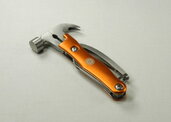
UST Hammer Beast Multi-tool
There are lots of multi-tools on the market – with most of them built around a set of pliers like Leatherman-type tools. Recently we came across the UST Hammer Beast which is built around a smooth-faced hammer instead of pliers – so we purchased it since a small hammer can be quite useful when you are camping in the back country. The criteria that we use to evaluate multi-tools are: 1) number of tools, 2) manufacturing quality of tools, 3) thoughtfulness of design, and 4) the specific functions that the tool can perform.
In addition to the smooth-faced hammer, the Hammer Beast has ten other tools to include: pliers, wire cutter, flat head screwdriver, Phillips screwdriver, nail puller, file, saw, knife blade, bottle opener and a wrench. The tool has a durable anodized aluminum handle for rust resistance and it’s orange so that you can easily spot it if you drop it in the backcountry. The Hammer Beast measures 5.75 x 1.75 x 0.6 inches and weighs 10.8 ounces.
There are lots of multi-tools on the market – with most of them built around a set of pliers like Leatherman-type tools. Recently we came across the UST Hammer Beast which is built around a smooth-faced hammer instead of pliers – so we purchased it since a small hammer can be quite useful when you are camping in the back country. The criteria that we use to evaluate multi-tools are: 1) number of tools, 2) manufacturing quality of tools, 3) thoughtfulness of design, and 4) the specific functions that the tool can perform.
In addition to the smooth-faced hammer, the Hammer Beast has ten other tools to include: pliers, wire cutter, flat head screwdriver, Phillips screwdriver, nail puller, file, saw, knife blade, bottle opener and a wrench. The tool has a durable anodized aluminum handle for rust resistance and it’s orange so that you can easily spot it if you drop it in the backcountry. The Hammer Beast measures 5.75 x 1.75 x 0.6 inches and weighs 10.8 ounces.
So if you’ve got room in your pack, or travel kit that you take with you when you’re hiking or camping, you ought to check it out. You can buy the “UST Hammer Beast Multi-Tool” at Amazon.
Folding Saw

Silky Ultra Accel Curved Blade Folding Saw, Large Teeth 240mm, 446-24
Although we normally use wood that either is deadfall, or is easily chopped with our hatchet or pack axe, sometimes we find that we need to saw something. Something that saw teeth on knives (which are really not made for sawing anything substantial) can’t cut. For those occasions you need a saw. If pack weight is not an overriding consideration the best option is a folding saw. The criteria that we use to evaluate folding saws are: 1) length, 2) strength, 3) weight, 4) number/type of teeth on saw, 5) diameter of log that can be cut, and 6) durability.
Although we normally use wood that either is deadfall, or is easily chopped with our hatchet or pack axe, sometimes we find that we need to saw something. Something that saw teeth on knives (which are really not made for sawing anything substantial) can’t cut. For those occasions you need a saw. If pack weight is not an overriding consideration the best option is a folding saw. The criteria that we use to evaluate folding saws are: 1) length, 2) strength, 3) weight, 4) number/type of teeth on saw, 5) diameter of log that can be cut, and 6) durability.
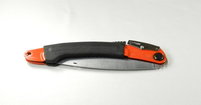
The Silky Ultra Accel Curved Blade folding saw is 20.75 inches long when in use, weighs approximately 10.4 ounces and folds to 11.75" x 3" x 1" when not in use. The saw has a curved blade attached to a lightweight aluminum frame wrapped in an easy-grip rubberized handle. This curved blade provides maximum speed and efficiency when cutting since it allows the teeth to stay in contact with the wood better. The blade locks in place when opened and has large teeth that are spaced so that there are 6.4 teeth per inch. As with all of the Silky curved blade outdoor saws, these are pure Japanese pull stroke saws with Silky's proprietary tooth design. While technically there is some cutting done on the push stroke, it is very minimal. The fact that the cutting is done on the pull stroke also keeps the blade from binding and bending like it often does on push stroke saws.
Some of the other differentiating features of the Silky Ultra Accel saw are: Non-Set Teeth: The blade is made from SK-4 high carbon steel and taper ground (e.g. thicker at the tooth edge, thinner at the back of the blade) to reduce resistance giving smoother, easier, faster cutting performance. Mirai-Me: The blade has four cutting angles along its length. It leaves a smooth surface after cutting and can rip-cut, cross-cut and slant-cut. Impulse Hardening: Using a special high frequency heating technique the teeth are heated instantly and hardened, and stay sharp about three times longer than non-hardened teeth. Because of this localized heating process only the teeth of the blade are heated and hardened. The remainder of the blade is unchanged and still retains its normal flexibility. Hard Chrome Plating: Produces an exceedingly high durable surface, and is resistant to rust and the effects of tree resins. Rubber Jacket on Handle: Light and comfortable rubber grip with rigid aluminum chassis to hold, reduce vibration and offer superior grip when hands are wet or cold and when wearing gloves. You can read even more about the saw’s technology on the Silky website.
The saw will easily cut through logs up to 6” in diameter, and larger logs if you can either rotate the log or vary your cutting position. Part #447-24 is the 9.5” (240mm) replacement blade for the Ultra Accel saw just in case you want a backup blade. You can buy this saw at Amazon.
Some of the other differentiating features of the Silky Ultra Accel saw are: Non-Set Teeth: The blade is made from SK-4 high carbon steel and taper ground (e.g. thicker at the tooth edge, thinner at the back of the blade) to reduce resistance giving smoother, easier, faster cutting performance. Mirai-Me: The blade has four cutting angles along its length. It leaves a smooth surface after cutting and can rip-cut, cross-cut and slant-cut. Impulse Hardening: Using a special high frequency heating technique the teeth are heated instantly and hardened, and stay sharp about three times longer than non-hardened teeth. Because of this localized heating process only the teeth of the blade are heated and hardened. The remainder of the blade is unchanged and still retains its normal flexibility. Hard Chrome Plating: Produces an exceedingly high durable surface, and is resistant to rust and the effects of tree resins. Rubber Jacket on Handle: Light and comfortable rubber grip with rigid aluminum chassis to hold, reduce vibration and offer superior grip when hands are wet or cold and when wearing gloves. You can read even more about the saw’s technology on the Silky website.
The saw will easily cut through logs up to 6” in diameter, and larger logs if you can either rotate the log or vary your cutting position. Part #447-24 is the 9.5” (240mm) replacement blade for the Ultra Accel saw just in case you want a backup blade. You can buy this saw at Amazon.
Chain/Wire Saw
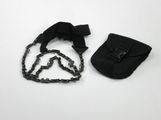
Chainmate CM-24SSP 24-Inch Survival Pocket Chain Saw With Pouch
Although we normally use wood that either is deadfall, or is easily chopped with our hatchet or pack axe, sometimes we find that we need to saw something. Something that saw teeth on knives (which are really not made for sawing anything substantial) can’t cut. For those occasions you need a saw. If pack weight is a consideration the best option is a chain/wire saw. The criteria that we use to evaluate chain/wire saws are: 1) length, 2) strength, 3) number/type of teeth on saw, and 4) durability. The Chainmate CM-24SSP Survival Pocket Chain Saw carbon steel saw is 24" long when in use, weighs approximately 4 ounces and compacts into a 3" x 4" x 2" pouch when not in use. You can buy this saw at Amazon.
Although we normally use wood that either is deadfall, or is easily chopped with our hatchet or pack axe, sometimes we find that we need to saw something. Something that saw teeth on knives (which are really not made for sawing anything substantial) can’t cut. For those occasions you need a saw. If pack weight is a consideration the best option is a chain/wire saw. The criteria that we use to evaluate chain/wire saws are: 1) length, 2) strength, 3) number/type of teeth on saw, and 4) durability. The Chainmate CM-24SSP Survival Pocket Chain Saw carbon steel saw is 24" long when in use, weighs approximately 4 ounces and compacts into a 3" x 4" x 2" pouch when not in use. You can buy this saw at Amazon.
Small Plastic Trowel
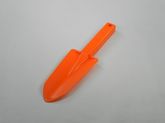
Coghlan's Backpackers Trowel
For digging in the backcountry there are normally only a couple of choices; your hands, a stick, a rock or a digging tool. Since it does’nt always make sense to carry a full shovel (even a folding one made for camping), we like to carry a small plastic trowel for these jobs. The criteria that we use to evaluate trowels are: 1) blade size, 2) strength and weight. This trowel is made of high-impact styrene plastic, measures 0.79" x 2.76" x 11.02" and weighs 2 oz. The blade is 6" long and its beveled edges cut through hard ground. Not a very high tech tool - but it does exactly what it was made for. You can buy this plastic trowel at Amazon.
For digging in the backcountry there are normally only a couple of choices; your hands, a stick, a rock or a digging tool. Since it does’nt always make sense to carry a full shovel (even a folding one made for camping), we like to carry a small plastic trowel for these jobs. The criteria that we use to evaluate trowels are: 1) blade size, 2) strength and weight. This trowel is made of high-impact styrene plastic, measures 0.79" x 2.76" x 11.02" and weighs 2 oz. The blade is 6" long and its beveled edges cut through hard ground. Not a very high tech tool - but it does exactly what it was made for. You can buy this plastic trowel at Amazon.
Folding Shovel with Case
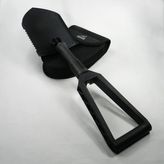
Gerber E-Tool Folding Spade (30-000075) with Rothco Gerber Nylon Tri Fold Shovel Cover
If you think that you are going to have to do some serious digging (e.g. for trail maintenance) then you need a real shovel; but one that can fold up and fit into your backpack. The criteria that we use to evaluate folding shovels are: 1) blade size, 2) folded out length, 3) folded up size, 4) strength, 5) ability to use your foot on the shovel, 6) blade lock, 7) available blade positions and 8) price. This shovel was originally designed for the NATO military troops, and has been issued to the US Marines. The shovel weighs just over 2 pounds and measures 9.37" in length when closed. When open the overall length is 23.75". The blade is serrated on one side to help with cutting roots while digging. The blade is made of powder coated boron carbon steel spade and the shaft is made of anodized 7075 aluminum. This shovel can really take a beating and keep on digging. For some reason the shovel does not come with the sheath so you need to buy that separately. You can buy this folding shovel and case at Amazon.
If you think that you are going to have to do some serious digging (e.g. for trail maintenance) then you need a real shovel; but one that can fold up and fit into your backpack. The criteria that we use to evaluate folding shovels are: 1) blade size, 2) folded out length, 3) folded up size, 4) strength, 5) ability to use your foot on the shovel, 6) blade lock, 7) available blade positions and 8) price. This shovel was originally designed for the NATO military troops, and has been issued to the US Marines. The shovel weighs just over 2 pounds and measures 9.37" in length when closed. When open the overall length is 23.75". The blade is serrated on one side to help with cutting roots while digging. The blade is made of powder coated boron carbon steel spade and the shaft is made of anodized 7075 aluminum. This shovel can really take a beating and keep on digging. For some reason the shovel does not come with the sheath so you need to buy that separately. You can buy this folding shovel and case at Amazon.
550 Paracord
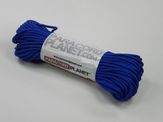
Paracord Planet Reflective 7-strand 4mm 550LB with Reflective Tracers - 200 feet
We always seem to find places that we need some kind of rope or string. So for most uses we use 550 paracord. The criteria that we use to evaluate paracord are: 1) strength, 2) visibility and 3) price). We like the Paracord Planet Reflective 7-strand 4mm 550LB with Reflective Tracers because it is strong enough to hold 550 lbs and the reflective tracers woven into the cord make it easy to see at night; and no one likes tripping over tarp ropes in the dark. You can buy this paracord at Amazon.
We always seem to find places that we need some kind of rope or string. So for most uses we use 550 paracord. The criteria that we use to evaluate paracord are: 1) strength, 2) visibility and 3) price). We like the Paracord Planet Reflective 7-strand 4mm 550LB with Reflective Tracers because it is strong enough to hold 550 lbs and the reflective tracers woven into the cord make it easy to see at night; and no one likes tripping over tarp ropes in the dark. You can buy this paracord at Amazon.
Nylon Rope
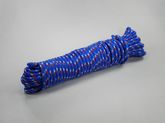
Wellington Multi-Purpose Saxon Poly Rope - 3/8" x 100'
Most of the time we make do with 550lb paracord, but sometimes we need stronger rope. When we do we use 3/8” Wellington Saxon Poly rope. The criteria that we use to evaluate nylon rope are: 1) strength, 2) stretch, 3) weight and 4) quality. This braided polypropylene rope is 3/8" thick and comes in 100' hemps. It is water resistant and also resists rot, mildew, oil and many other chemicals. You can buy this nylon rope at Amazon or your local hardware store.
Most of the time we make do with 550lb paracord, but sometimes we need stronger rope. When we do we use 3/8” Wellington Saxon Poly rope. The criteria that we use to evaluate nylon rope are: 1) strength, 2) stretch, 3) weight and 4) quality. This braided polypropylene rope is 3/8" thick and comes in 100' hemps. It is water resistant and also resists rot, mildew, oil and many other chemicals. You can buy this nylon rope at Amazon or your local hardware store.
Survival Fishing Kit
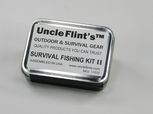
Uncle Flint’s Survival Fishing Kit II
If you find the need to fish while on your adventure (and you have the right license to do so) then one of the things that you might consider carrying in your backpack is some fishing gear. The only problem with that is that you can quickly fill your pack with fishing rods and other tackle. That’s not our objective, but we do like to have the minimum essentials to fish with us just in case. The criteria that we use to evaluate fishing kits are: 1) amount of items, 2) type of items, 3) packed size, 4) weight and 5) thoughtfulness of the kit’s layout. We carry the Uncle Flints Survival Fishing Kit II since it is very compact and has over 64 pieces of fishing tackle. It comes in a 4.25” x 3.125” x 1” steel storage container with a hinged lid and weighs approximately 5.5 ounces. The kit includes:
If you find the need to fish while on your adventure (and you have the right license to do so) then one of the things that you might consider carrying in your backpack is some fishing gear. The only problem with that is that you can quickly fill your pack with fishing rods and other tackle. That’s not our objective, but we do like to have the minimum essentials to fish with us just in case. The criteria that we use to evaluate fishing kits are: 1) amount of items, 2) type of items, 3) packed size, 4) weight and 5) thoughtfulness of the kit’s layout. We carry the Uncle Flints Survival Fishing Kit II since it is very compact and has over 64 pieces of fishing tackle. It comes in a 4.25” x 3.125” x 1” steel storage container with a hinged lid and weighs approximately 5.5 ounces. The kit includes:
- (50) feet of 20 lb test monofilament fishing line
- (50) feet of 40 lb test monofilament fishing line
- (1) floating jig head lure, size small
- (1) floating jig head lure, size medium
- (1) floating jig head lure, size large
- (6) plastic twist tail lures
- (1) metallic flasher spinning lure
- (1) metal spoon lure
- (1) artificial fly lure
- (2) treble hooks, size 1
- (3) Tru-Turn catfish hooks, size 2/0
- (3) circle hooks, size 2
- (3) baitholder hooks, size 4
- (3) baitholder hooks, size 6
- (3) baitholder hooks, size 8
- (3) panfish hooks, size 12
- (2) snap swivels, size 3
- (2) snap swivels, size 6
- (2) snap swivels, size 8
- (2) snap swivels, size 10
- (2) coated steel leaders, 20 lb test
- (2) coated steel leaders, 40 lb test
- (10) split-shot sinkers
- (2) round plastic bobbers size 3/4 inch
- (2) large (size 3) safety pins
- (2) XX-large (size 7) safety pins
- MiniScraper single edge razor blade and plastic holder
- Aluminum foil, one piece, folded, heavy duty, approximately 12 inches x 24 inches
- Basic fishing knot tying instruction sheet
Fishing Line
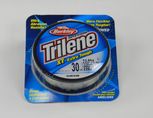
30 lb Berkley Trilene Clear Fishing Line - 220 yards
Although we advocate carrying a spool of fishing line with you when camping, it’s not just for fishing; it’s also for all those other applications where you need a strong string to tie something. The criteria that we use to evaluate fishing lines are: 1) strength, 2) length and 3) price. We carry 30 lb Berkley Trilene clear fishing line because it was designed for heavy cover bass fishing and consequently doesn’t fray or break when it gets snagged on something at the campsite since it’s abrasion resistant against sharp objects, tough and has a low stretch. You can buy this fishing line at Amazon.
Although we advocate carrying a spool of fishing line with you when camping, it’s not just for fishing; it’s also for all those other applications where you need a strong string to tie something. The criteria that we use to evaluate fishing lines are: 1) strength, 2) length and 3) price. We carry 30 lb Berkley Trilene clear fishing line because it was designed for heavy cover bass fishing and consequently doesn’t fray or break when it gets snagged on something at the campsite since it’s abrasion resistant against sharp objects, tough and has a low stretch. You can buy this fishing line at Amazon.
Survival Fishing Net
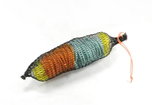
Best Glide ASE Adventurer Survival Gill Net
For our normal fishing adventures in the outback we carry Uncle Flint’s Survival Fishing Kit II and 220 yards of 30 lb Berkley Trilene clear fishing line. But line fishing, with either a pole or by hand, takes time since you have to be present at all times to be effective. In a real survival situation this is not practical. So “just in case” we also have a gill net with our other “deep” survival gear since it can be set up and left unattended while your time is devoted to building survival shelter, providing medical attention, signaling or other survival activities. Any of you that have watched the TV Series “Alone” know how handy a gill net can be.
The criteria that we use to evaluate survival gill nets are: 1) length, 2) width, 3) weight, 4) materials, and 5) construction quality. The net that we purchased is the Best Glide ASE Adventurer Survival Gill Net. The net is quite sturdy since it is made of commercial-grade components. The net has 24’ of rope, top and bottom, to stretch across a river or stream. When spread out it measures 12’ x 4’ and has a 1.5" mesh. The netting is hung on the diamond to give the net maximum stretch. This allows flexibility in areas requiring up to a 19’ length net with only a 2’ depth. Or the gill net can be stretched to a 4’ length and a depth of approximately 5’ by placing a knot through the corner of the netting to the rope on the top and the bottom of the net. The leaded foot (bottom) rope of the gill net acts as the weight to sink the net and the top rope is made of polypropylene that floats. In a real emergency the gill net can also be used as a small seine net or is strong enough that it could also be used as a trap for rabbits, partridge, pheasants and other small game. The gill net comes in a mesh bag, measures 10” x 3” when stowed and weighs ~9 oz. Please note that gill nets should only be used for survival applications since they are outlawed in most states for sport fishing. You can buy the Best Glide ASE Adventurer Survival Gill Net at Amazon.
For our normal fishing adventures in the outback we carry Uncle Flint’s Survival Fishing Kit II and 220 yards of 30 lb Berkley Trilene clear fishing line. But line fishing, with either a pole or by hand, takes time since you have to be present at all times to be effective. In a real survival situation this is not practical. So “just in case” we also have a gill net with our other “deep” survival gear since it can be set up and left unattended while your time is devoted to building survival shelter, providing medical attention, signaling or other survival activities. Any of you that have watched the TV Series “Alone” know how handy a gill net can be.
The criteria that we use to evaluate survival gill nets are: 1) length, 2) width, 3) weight, 4) materials, and 5) construction quality. The net that we purchased is the Best Glide ASE Adventurer Survival Gill Net. The net is quite sturdy since it is made of commercial-grade components. The net has 24’ of rope, top and bottom, to stretch across a river or stream. When spread out it measures 12’ x 4’ and has a 1.5" mesh. The netting is hung on the diamond to give the net maximum stretch. This allows flexibility in areas requiring up to a 19’ length net with only a 2’ depth. Or the gill net can be stretched to a 4’ length and a depth of approximately 5’ by placing a knot through the corner of the netting to the rope on the top and the bottom of the net. The leaded foot (bottom) rope of the gill net acts as the weight to sink the net and the top rope is made of polypropylene that floats. In a real emergency the gill net can also be used as a small seine net or is strong enough that it could also be used as a trap for rabbits, partridge, pheasants and other small game. The gill net comes in a mesh bag, measures 10” x 3” when stowed and weighs ~9 oz. Please note that gill nets should only be used for survival applications since they are outlawed in most states for sport fishing. You can buy the Best Glide ASE Adventurer Survival Gill Net at Amazon.
Small Animal Snare kit
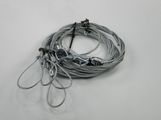
Dakotaline Survival Snare Package
Very rarely have we ever had to use an animal snare, but if you do then it’s best to use a real snare rather than a jury rigged one. The criteria that we use to evaluate animal snares are: 1) size of snares, 2) types of animals targeted, 3) strength of snares, 4) quality of construction and 5) price. We use the Dakotaline Survival Snare Package which has 3 different sized snares that allow you to catch animals from rabbits to hogs. The 4 small game snares are made to catch squirrel and rabbit sized animals and are constructed out of 3/64", 7x7 cable and are 30" long with an 11 gauge swivel on the anchor end. The 4 medium game snares are made to catch animals from raccoons to coyotes and are constructed out of 3/32",7x7 cable and are 60" long with a 9 gauge swivel on the anchor end. The 4 large game snares are made to catch animals up to the size of a hog and are constructed out of 1/8", 7x7 cable and are 84" long with an adjustable loop on the anchor end. These are professional grade snares; which is what you want to have if you ever need them. You can buy these snares at Amazon.
Very rarely have we ever had to use an animal snare, but if you do then it’s best to use a real snare rather than a jury rigged one. The criteria that we use to evaluate animal snares are: 1) size of snares, 2) types of animals targeted, 3) strength of snares, 4) quality of construction and 5) price. We use the Dakotaline Survival Snare Package which has 3 different sized snares that allow you to catch animals from rabbits to hogs. The 4 small game snares are made to catch squirrel and rabbit sized animals and are constructed out of 3/64", 7x7 cable and are 30" long with an 11 gauge swivel on the anchor end. The 4 medium game snares are made to catch animals from raccoons to coyotes and are constructed out of 3/32",7x7 cable and are 60" long with a 9 gauge swivel on the anchor end. The 4 large game snares are made to catch animals up to the size of a hog and are constructed out of 1/8", 7x7 cable and are 84" long with an adjustable loop on the anchor end. These are professional grade snares; which is what you want to have if you ever need them. You can buy these snares at Amazon.
Braided Steel Wire
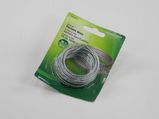
Hillman Group/Anchor Wire #3/30 lb Picture Wire - 50 feet
Just like the fishing line that we carry we find having braided wire with us helpful in all sorts of situations. Since single strand wire can break fairly easily we prefer multi-strand wire. The criteria that we use to evaluate braided wire are: 1) strength, 2) length and 3) weight. As with the fishing line we use 30 lb braided picture wire since it is strong without being too heavy. You can buy this braided steel wire at Amazon or your local hardware store.
Just like the fishing line that we carry we find having braided wire with us helpful in all sorts of situations. Since single strand wire can break fairly easily we prefer multi-strand wire. The criteria that we use to evaluate braided wire are: 1) strength, 2) length and 3) weight. As with the fishing line we use 30 lb braided picture wire since it is strong without being too heavy. You can buy this braided steel wire at Amazon or your local hardware store.
Camping Shower/Water Pump
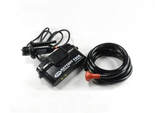
ZODI Outback Gear Battery Powered Shower
If you are camping in the outback sometimes it’s nice to wash more than just your hands. If there’s a pond or deep stream nearby, and you don’t mind the brace of cold water, then you can just jump in. However, since you probably don’t want to use soap when you do this (even biodegradable soap like Campsuds), a better solution is to take a shower – especially a warm shower. But that’s not easy to do in the outback. To solve this problem we looked at the portable showers that are on the market. The criteria that we use to evaluate portable showers are: 1) water flow, 2) size, 3) weight, 4) hose length, and 5) construction quality. After looking at all the options we purchased a Zodi Outback Gear Battery Powered Shower. The shower has three main components: battery case, pump and shower hose with a water-conserving nozzle. The largest component is the battery case (with on/off switch). It measures 7” x 3 ½“ x 2 “ and is used to store 4 “D” cell batteries (which are the heaviest part of the whole setup). The battery pack has a 4 foot cord to the pump. The pump is a small 6-volt self-contained unit with a removable debris filter measuring 5” tall by 2 ½“ in diameter. The pump connects to an 8 foot shower hose and is made to be submerged in the water. With the batteries the pump weighs ~2 lbs. Once setup and running, in any water source, the pump’s water flow is ~1 gallon per minute. For a warm shower we just fill our 2.5 Liter collapsible water jug, let it sit in the sun to warm up then put the pump into the jug and shower away.
Another advantage that we have found with the Zodi Shower is that it can be used as a water pump in addition to being a shower. Need to pump water into your campsite’s water jug? The Zodi pump makes this easy to do. Even though it is packaged as a shower, the pump is ideal for rinsing dishes, cleaning up, washing pets or being used as a back-up bilge pump for jet skis, canoes and kayaks. Although it is probably not that practical for lightweight hiking/camping, where your pack weight is one of your most significant concerns, we like the fact that the Zodi shower has multiple uses and is compact enough that it is easy to store and carry. You can buy the ZODI Outback Gear Battery Powered Shower at Amazon.
If you are camping in the outback sometimes it’s nice to wash more than just your hands. If there’s a pond or deep stream nearby, and you don’t mind the brace of cold water, then you can just jump in. However, since you probably don’t want to use soap when you do this (even biodegradable soap like Campsuds), a better solution is to take a shower – especially a warm shower. But that’s not easy to do in the outback. To solve this problem we looked at the portable showers that are on the market. The criteria that we use to evaluate portable showers are: 1) water flow, 2) size, 3) weight, 4) hose length, and 5) construction quality. After looking at all the options we purchased a Zodi Outback Gear Battery Powered Shower. The shower has three main components: battery case, pump and shower hose with a water-conserving nozzle. The largest component is the battery case (with on/off switch). It measures 7” x 3 ½“ x 2 “ and is used to store 4 “D” cell batteries (which are the heaviest part of the whole setup). The battery pack has a 4 foot cord to the pump. The pump is a small 6-volt self-contained unit with a removable debris filter measuring 5” tall by 2 ½“ in diameter. The pump connects to an 8 foot shower hose and is made to be submerged in the water. With the batteries the pump weighs ~2 lbs. Once setup and running, in any water source, the pump’s water flow is ~1 gallon per minute. For a warm shower we just fill our 2.5 Liter collapsible water jug, let it sit in the sun to warm up then put the pump into the jug and shower away.
Another advantage that we have found with the Zodi Shower is that it can be used as a water pump in addition to being a shower. Need to pump water into your campsite’s water jug? The Zodi pump makes this easy to do. Even though it is packaged as a shower, the pump is ideal for rinsing dishes, cleaning up, washing pets or being used as a back-up bilge pump for jet skis, canoes and kayaks. Although it is probably not that practical for lightweight hiking/camping, where your pack weight is one of your most significant concerns, we like the fact that the Zodi shower has multiple uses and is compact enough that it is easy to store and carry. You can buy the ZODI Outback Gear Battery Powered Shower at Amazon.
Flexible Plastic Tubing
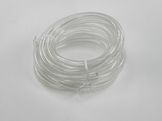
Samar Company 3/8" Vinyl Tubing – 20 feet
It may seem odd but we have had occasions where we had to run water from one point to another. To accomplish this we used 3/8” vinyl tubing. The criteria that we use to evaluate vinyl tubing are: 1) length, 2) internal diameter, 3) external diameter, and 4) thickness. We like the Samar Company 3/8” vinyl tubing since it is pliable and remains fairly flexible when cold. You can buy this plastic tubing at Amazon or your local hardware store.
It may seem odd but we have had occasions where we had to run water from one point to another. To accomplish this we used 3/8” vinyl tubing. The criteria that we use to evaluate vinyl tubing are: 1) length, 2) internal diameter, 3) external diameter, and 4) thickness. We like the Samar Company 3/8” vinyl tubing since it is pliable and remains fairly flexible when cold. You can buy this plastic tubing at Amazon or your local hardware store.
Tubing Clamps
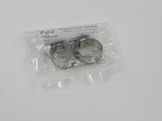
American Valve 1/4" to 5/8" Stainless Steel Hose Clamps – 4 clamps
To go with the vinyl tubing you need clamps. We find that the best type of clamps are stainless steel hose clamps since they tighten down around the outside of the tubing and make a watertight seal. The criteria that we use to evaluate tubing clamps are: 1) diameter, 2) adjustability, 3) strength and 4) rust resistance. We like American Valve 1/4" to 5/8" Stainless Steel Hose Clamps since they easily fit around the 3/8” tubing with room to spare, are stainless steel to prevent rusting and tighten up with a screwdriver bit. You can buy these tubing clamps at Amazon or your local hardware store.
To go with the vinyl tubing you need clamps. We find that the best type of clamps are stainless steel hose clamps since they tighten down around the outside of the tubing and make a watertight seal. The criteria that we use to evaluate tubing clamps are: 1) diameter, 2) adjustability, 3) strength and 4) rust resistance. We like American Valve 1/4" to 5/8" Stainless Steel Hose Clamps since they easily fit around the 3/8” tubing with room to spare, are stainless steel to prevent rusting and tighten up with a screwdriver bit. You can buy these tubing clamps at Amazon or your local hardware store.
Hockey Stick Tape for Wrapping Tool Handles
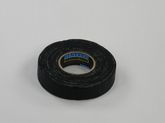
Renfrew Black Cloth Hockey Tape – 1” wide
On several of our hand tools we find that using them makes the handles smoother and slipperier. To combat this we put hockey tape on the handles. This really gives us a much better grip on what can be dangerous tools. The criteria that we use to evaluate hockey stick tape are: 1) stickiness and 2) resistance to weather. You can buy this hockey tape at Amazon.
On several of our hand tools we find that using them makes the handles smoother and slipperier. To combat this we put hockey tape on the handles. This really gives us a much better grip on what can be dangerous tools. The criteria that we use to evaluate hockey stick tape are: 1) stickiness and 2) resistance to weather. You can buy this hockey tape at Amazon.
Large Binoculars
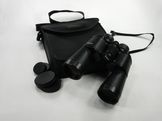
Nikon Action 10 x 50 - 6 Degree Lookout II Binoculars
If we plan on doing casual animal or bird watching we take our small Meade 10 x 32 binoculars that we normally use for hiking since they are small and compact. If we want to see further, we need to take larger binoculars. The criteria that we use to evaluate large binoculars are: 1) maximum magnification, 2) fine adjustability, 3) size, 4) weight and 5) price. When we need to take larger binoculars we take our Nikon Action 10 x 50 - 6 Degree Lookout II binoculars. These binoculars are much clearer since they have 50mm objective lenses. But they are also bigger (4.2” x 8.4” x 9.6") and heavier (2 ¾ lbs). Although you can no longer buy these specific binoculars, you can buy the current version of these binoculars at Amazon.
If we plan on doing casual animal or bird watching we take our small Meade 10 x 32 binoculars that we normally use for hiking since they are small and compact. If we want to see further, we need to take larger binoculars. The criteria that we use to evaluate large binoculars are: 1) maximum magnification, 2) fine adjustability, 3) size, 4) weight and 5) price. When we need to take larger binoculars we take our Nikon Action 10 x 50 - 6 Degree Lookout II binoculars. These binoculars are much clearer since they have 50mm objective lenses. But they are also bigger (4.2” x 8.4” x 9.6") and heavier (2 ¾ lbs). Although you can no longer buy these specific binoculars, you can buy the current version of these binoculars at Amazon.
